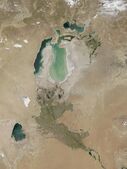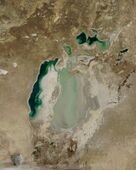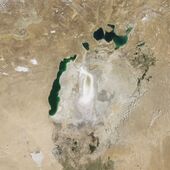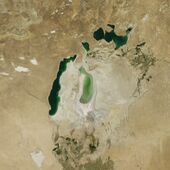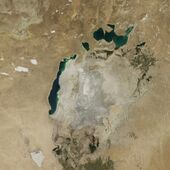بحر آرال الجنوبي
| بحر آرال الجنوبي South Aral Sea | |
|---|---|
 الجزء الجنوبي من بحر آرال مازال بادياً بين صخور هضبة أوست يورت، مايو 2012. | |
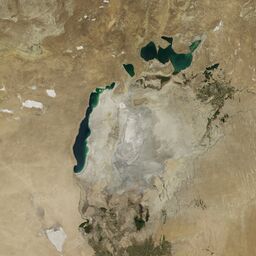 بحر آرال في منتصف أغسطس 2014. البحيرتان الباقيتان إلى الجنوب والغرب هما ما تبقى من بحر آرال الجنوبي | |
| الموقع | قزخستان–أوزبكستان، آسيا الوسطى |
| الاحداثيات | 45°00′N 58°30′E / 45°N 58.5°E |
| النوع | حوض تجميعي، بحيرة طبيعية |
| الموارد الرئيسية | المياه الجوفية فقط (سابقاً جيحون) |
| بلدان الحوض | قزخستان وأوزبكستان |
| مساحة السطح | West Aral Sea: 3,500 km2 (1,350 sq mi) (2005) (fluctuating area of Eastern Sea) 42,100 km2 (16,250 sq mi) (1989) |
| متوسط العمق | 14–15 m (46–49 ft) (2005) |
| أقصى عمق | 37–40 m (121–131 ft) (2005) |
| ارتفاع السطح | 29 m (95 ft) (2007) |
| المراجع | [1] |
بحر آرال الجنوبي South Aral Sea كان بحيرة في حضو بحر آرال السابق والتي تشكلت في 1987 حين انقسم ذلك المسطح المائي إلى اثنين، بسبب تحويل مياه النهر لأغراض الزراعة. In 2003, the South Aral Sea itself split into eastern and western basins, the Eastern Sea and the West Aral Sea, connected by a narrow channel (channel bed at an elevation of 29 m (95 ft)) that balanced surface levels but did not allow mixing, and in 2005 the North Aral Sea was dammed to prevent the collapse of its fisheries, cutting off the only remaining inflow to the southern lakes. In 2008, the Eastern Sea split again, and in May 2009 had almost completely dried out, leaving only the small permanent Barsakelmes Lake between the Northern and Western Seas and increasing the expanse of the Aralkum desert.[2][3] In 2010, it was partially filled again by meltwater,[4] and by 2014 was once again dry. The West Aral Sea has some replenishment from groundwater in the northwest,[5] and so is likely to avoid desiccation.
خلفية
The Aral Sea began shrinking in the 1960s, when the Soviet Union decided that the two rivers feeding it, the Amu Darya and the Syr Darya, would be diverted in order to irrigate cotton and food crops in Kazakhstan and Uzbekistan. In 1987, due to an accelerated loss of water, the Aral Sea was split into northern and southern parts; the northern part is the current North Aral Sea.
الملوحة
In 2007, the western basin had a salinity of 70 g/L and the eastern basin 100 g/L. Once the water level falls below the connecting channel (elevation 29 m), the salinities can be expected to diverge further. Under current conditions, the eastern basin may receive water from the Amu Darya in wet years, fluctuating in salinity and flooding an area of up to 4500 km2 in salt water to a depth of about one meter, which would preclude any economic activity in the area, while the western basin becomes increasingly saline.[6] Water diversion from the Amu Darya directly to the deeper western basin could lower its salinity enough to allow resumption of local fisheries, while allowing the eastern basin to desiccate almost entirely and avoiding the problems of flooding.[7]
الوضع الحالي
The West Aral Sea is expected to stabilize at 2,700–3,500 km2 (1,040–1,350 sq mi), a mean depth of 14–15 m (46–49 ft), and a maximum depth of 37–40 m (121–131 ft), assuming groundwater discharge at the rate of 2 km3 (0.5 cu mi) per year.[6] The Eastern Sea dried up completely in the summer of 2009, apart from the small permanent Barsakelmes Lake (between the Northern and Western seas), but it received some water from snow melt in the spring of 2010. It is expected to alternate between complete desiccation in the summers and the occasional flood from the Amu Darya or spillover from the dam holding back the North Aral Sea, though a second dike, begun in 2010, may reduce the incidence of the latter.
August 2009 – The Eastern Sea's mud flats have dried further, with only the faintest glimmer of water where it drains into the Western Sea. Barsakelmes Lake appears between the Northern and Western seas.
July 2010 – A closeup of the channel leading from the re-flooded Eastern Sea to the Western Sea. The white areas are the exposed salt flats of the new Aralkum desert.
August 2010 – Part of the Eastern Sea has been re-flooded by the Amu Darya from heavy snowmelt.
In 2015, the Western Sea was starting to split into two, as the channel that connects the central part of the sea and the small North-Eastern part was growing skinnier. (This can be seen on the 2014 picture.) Since 2018, the split has been complete.[8][9]
المراجع
- ^ "Seen from Space – South Aral Sea shrinking but North Aral Sea expanding". EORC. Retrieved 31 May 2017.
- ^ Harald Frater (10 August 2009). "scinexx | Aralsee: Ostbecken ist jetzt Wüste: Satellitenaufnahmen dokumentieren dramatische Austrocknung der letzen Jahre – Wüsten, Aralsee, Desertifikation, Wasser, Bewässerung, Landschaft, Landwirtschaft, Flüsse". Scinexx.de. Retrieved 2013-09-01.
- ^ "Freshwater Ecoregions of the World". Feow.org. 2013-02-26. Archived from the original on 19 February 2012. Retrieved 2013-09-01.
- ^ "The Shrinking Aral Sea Recovers : Image of the Day". Earthobservatory.nasa.gov. 30 October 2010. doi:10.1111/j.1440-1770.2010.00437.x. Retrieved 2013-09-01.
{{cite journal}}: Cite journal requires|journal=(help) - ^ Jarsjö, Jerker; Destouni, Georgia (2004). "Groundwater discharge into the Aral Sea after 1960". Journal of Marine Systems. 47 (1–4): 109–120. Bibcode:2004JMS....47..109J. doi:10.1016/j.jmarsys.2003.12.013.
- ^ أ ب Peter O. Zavialov, 2005, Physical oceanography of the dying Aral Sea, p 112
- ^ "The rehabilitation of the ecosystem and bioproductivity of the Aral Sea under conditions of water scarcity" (rev. August 2007)
- ^ https://www.weforum.org/agenda/2020/02/aral-sea-lake-water-nature-human-impact/ Satellite image of 2018
- ^ https://eurasianet.org/northern-arals-promise-stunted-by-dam-height-international-disputes Satellite image of 2020


